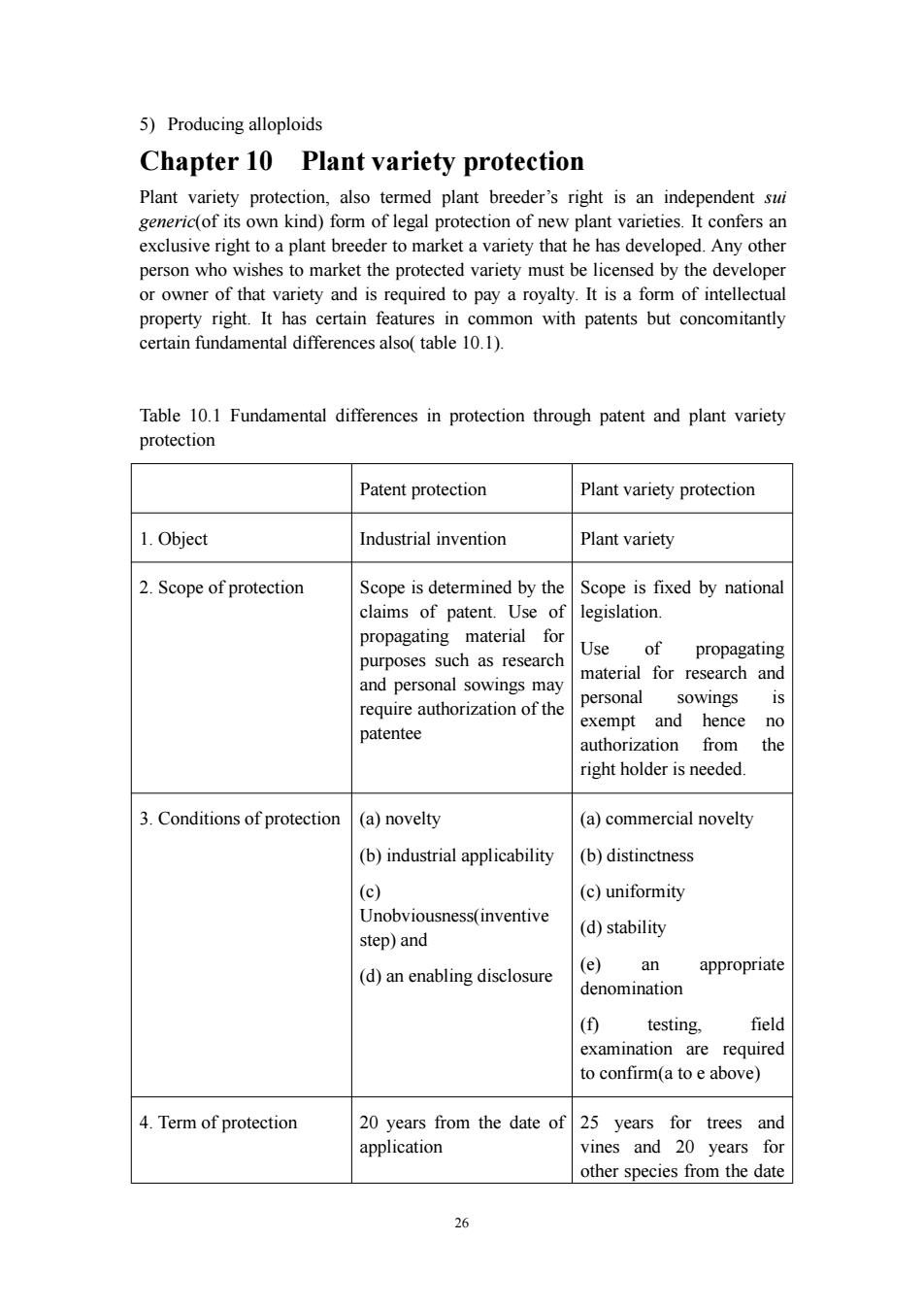
5)Producing alloploids Chapter 10 Plant variety protection Plant variety protection,also termed plant breeder's right is an independent sui generic(of its own kind)form of legal protection of new plant varieties.It confers an exclusive right to a plant breeder to market a variety that he has developed.Any other person who wishes to market the protected variety must be licensed by the developer or owner of that variety and is required to pay a royalty.It is a form of intellectual property right.It has certain features in common with patents but concomitantly certain fundamental differences also(table 10.1). Table 10.1 Fundamental differences in protection through patent and plant variety protection Patent protection Plant variety protection 1.Object Industrial invention Plant variety 2.Scope of protection Scope is determined by the Scope is fixed by national claims of patent.Use of legislation. propagating material for Use of purposes such as research propagating material for research and and personal sowings may personal sowings IS require authorization of the exempt and hence no patentee authorization from the right holder is needed. 3.Conditions of protection (a)novelty (a)commercial novelty (b)industrial applicability (b)distinctness (c) (c)uniformity Unobviousness(inventive (d)stability step)and (e) an (d)an enabling disclosure appropriate denomination (⑤ testing, field examination are required to confirm(a to e above) 4.Term of protection 20 years from the date of 25 years for trees and application vines and 20 years for other species from the date 26
26 5) Producing alloploids Chapter 10 Plant variety protection Plant variety protection, also termed plant breeder’s right is an independent sui generic(of its own kind) form of legal protection of new plant varieties. It confers an exclusive right to a plant breeder to market a variety that he has developed. Any other person who wishes to market the protected variety must be licensed by the developer or owner of that variety and is required to pay a royalty. It is a form of intellectual property right. It has certain features in common with patents but concomitantly certain fundamental differences also( table 10.1). Table 10.1 Fundamental differences in protection through patent and plant variety protection Patent protection Plant variety protection 1. Object Industrial invention Plant variety 2. Scope of protection Scope is determined by the claims of patent. Use of propagating material for purposes such as research and personal sowings may require authorization of the patentee Scope is fixed by national legislation. Use of propagating material for research and personal sowings is exempt and hence no authorization from the right holder is needed. 3. Conditions of protection (a) novelty (b) industrial applicability (c) Unobviousness(inventive step) and (d) an enabling disclosure (a) commercial novelty (b) distinctness (c) uniformity (d) stability (e) an appropriate denomination (f) testing, field examination are required to confirm(a to e above) 4. Term of protection 20 years from the date of application 25 years for trees and vines and 20 years for other species from the date
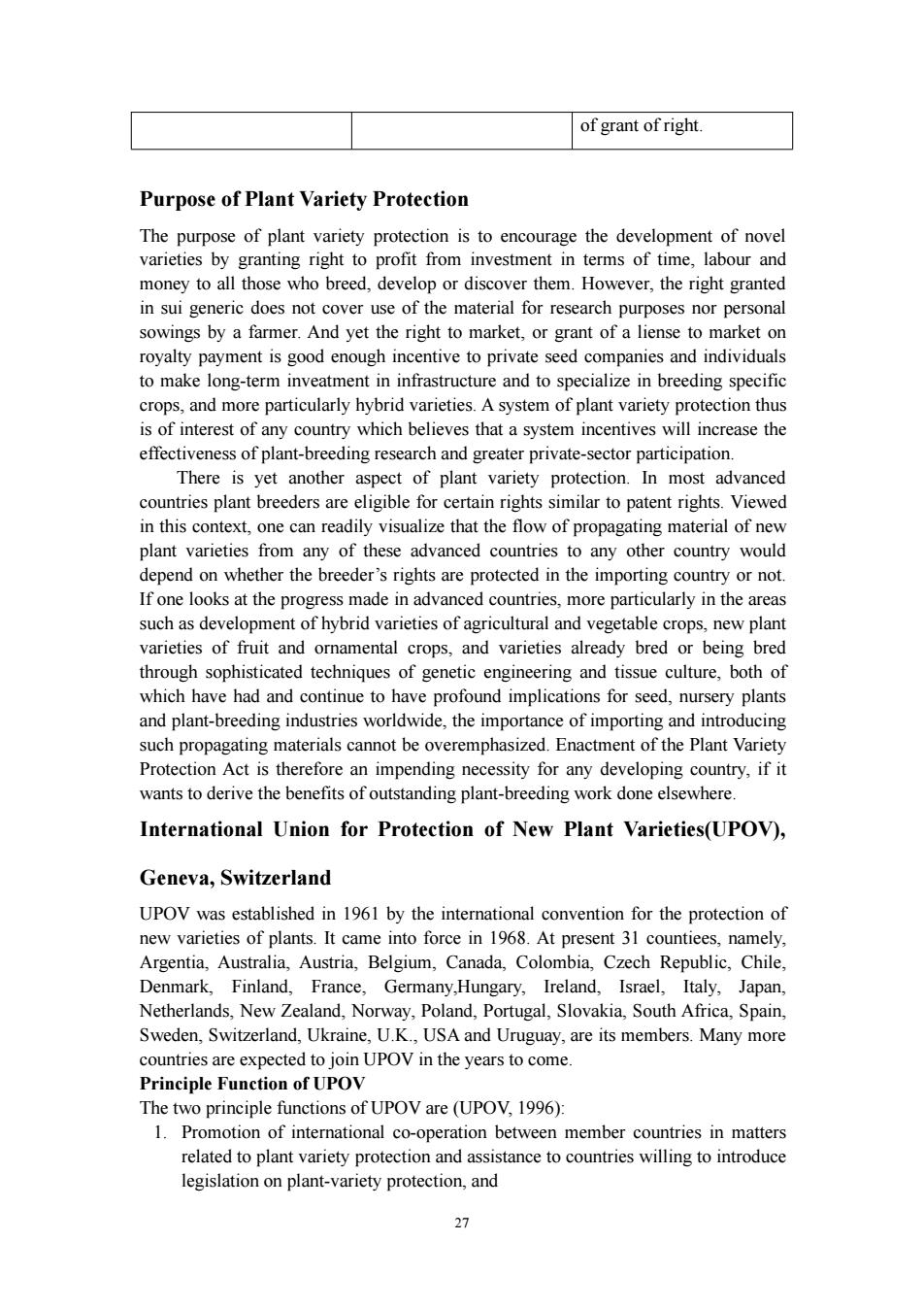
of grant of right. Purpose of Plant Variety Protection The purpose of plant variety protection is to encourage the development of novel varieties by granting right to profit from investment in terms of time,labour and money to all those who breed,develop or discover them.However,the right granted in sui generic does not cover use of the material for research purposes nor personal sowings by a farmer.And yet the right to market,or grant of a liense to market on royalty payment is good enough incentive to private seed companies and individuals to make long-term inveatment in infrastructure and to specialize in breeding specific crops,and more particularly hybrid varieties.A system of plant variety protection thus is of interest of any country which believes that a system incentives will increase the effectiveness of plant-breeding research and greater private-sector participation. There is yet another aspect of plant variety protection.In most advanced countries plant breeders are eligible for certain rights similar to patent rights.Viewed in this context,one can readily visualize that the flow of propagating material of new plant varieties from any of these advanced countries to any other country would depend on whether the breeder's rights are protected in the importing country or not. If one looks at the progress made in advanced countries,more particularly in the areas such as development of hybrid varieties of agricultural and vegetable crops,new plant varieties of fruit and ornamental crops,and varieties already bred or being bred through sophisticated techniques of genetic engineering and tissue culture,both of which have had and continue to have profound implications for seed,nursery plants and plant-breeding industries worldwide,the importance of importing and introducing such propagating materials cannot be overemphasized.Enactment of the Plant Variety Protection Act is therefore an impending necessity for any developing country,if it wants to derive the benefits of outstanding plant-breeding work done elsewhere. International Union for Protection of New Plant Varieties(UPOV), Geneva,Switzerland UPOV was established in 1961 by the international convention for the protection of new varieties of plants.It came into force in 1968.At present 31 countiees,namely, Argentia,Australia,Austria,Belgium,Canada,Colombia,Czech Republic,Chile, Denmark,Finland,France,Germany,Hungary,Ireland,Israel,Italy,Japan, Netherlands,New Zealand,Norway,Poland,Portugal,Slovakia,South Africa,Spain, Sweden,Switzerland,Ukraine,U.K.,USA and Uruguay,are its members.Many more countries are expected to join UPOV in the years to come. Principle Function of UPOV The two principle functions of UPOV are(UPOV,1996): 1.Promotion of international co-operation between member countries in matters related to plant variety protection and assistance to countries willing to introduce legislation on plant-variety protection,and 27
27 of grant of right. Purpose of Plant Variety Protection The purpose of plant variety protection is to encourage the development of novel varieties by granting right to profit from investment in terms of time, labour and money to all those who breed, develop or discover them. However, the right granted in sui generic does not cover use of the material for research purposes nor personal sowings by a farmer. And yet the right to market, or grant of a liense to market on royalty payment is good enough incentive to private seed companies and individuals to make long-term inveatment in infrastructure and to specialize in breeding specific crops, and more particularly hybrid varieties. A system of plant variety protection thus is of interest of any country which believes that a system incentives will increase the effectiveness of plant-breeding research and greater private-sector participation. There is yet another aspect of plant variety protection. In most advanced countries plant breeders are eligible for certain rights similar to patent rights. Viewed in this context, one can readily visualize that the flow of propagating material of new plant varieties from any of these advanced countries to any other country would depend on whether the breeder’s rights are protected in the importing country or not. If one looks at the progress made in advanced countries, more particularly in the areas such as development of hybrid varieties of agricultural and vegetable crops, new plant varieties of fruit and ornamental crops, and varieties already bred or being bred through sophisticated techniques of genetic engineering and tissue culture, both of which have had and continue to have profound implications for seed, nursery plants and plant-breeding industries worldwide, the importance of importing and introducing such propagating materials cannot be overemphasized. Enactment of the Plant Variety Protection Act is therefore an impending necessity for any developing country, if it wants to derive the benefits of outstanding plant-breeding work done elsewhere. International Union for Protection of New Plant Varieties(UPOV), Geneva, Switzerland UPOV was established in 1961 by the international convention for the protection of new varieties of plants. It came into force in 1968. At present 31 countiees, namely, Argentia, Australia, Austria, Belgium, Canada, Colombia, Czech Republic, Chile, Denmark, Finland, France, Germany,Hungary, Ireland, Israel, Italy, Japan, Netherlands, New Zealand, Norway, Poland, Portugal, Slovakia, South Africa, Spain, Sweden, Switzerland, Ukraine, U.K., USA and Uruguay, are its members. Many more countries are expected to join UPOV in the years to come. Principle Function of UPOV The two principle functions of UPOV are (UPOV, 1996): 1. Promotion of international co-operation between member countries in matters related to plant variety protection and assistance to countries willing to introduce legislation on plant-variety protection, and
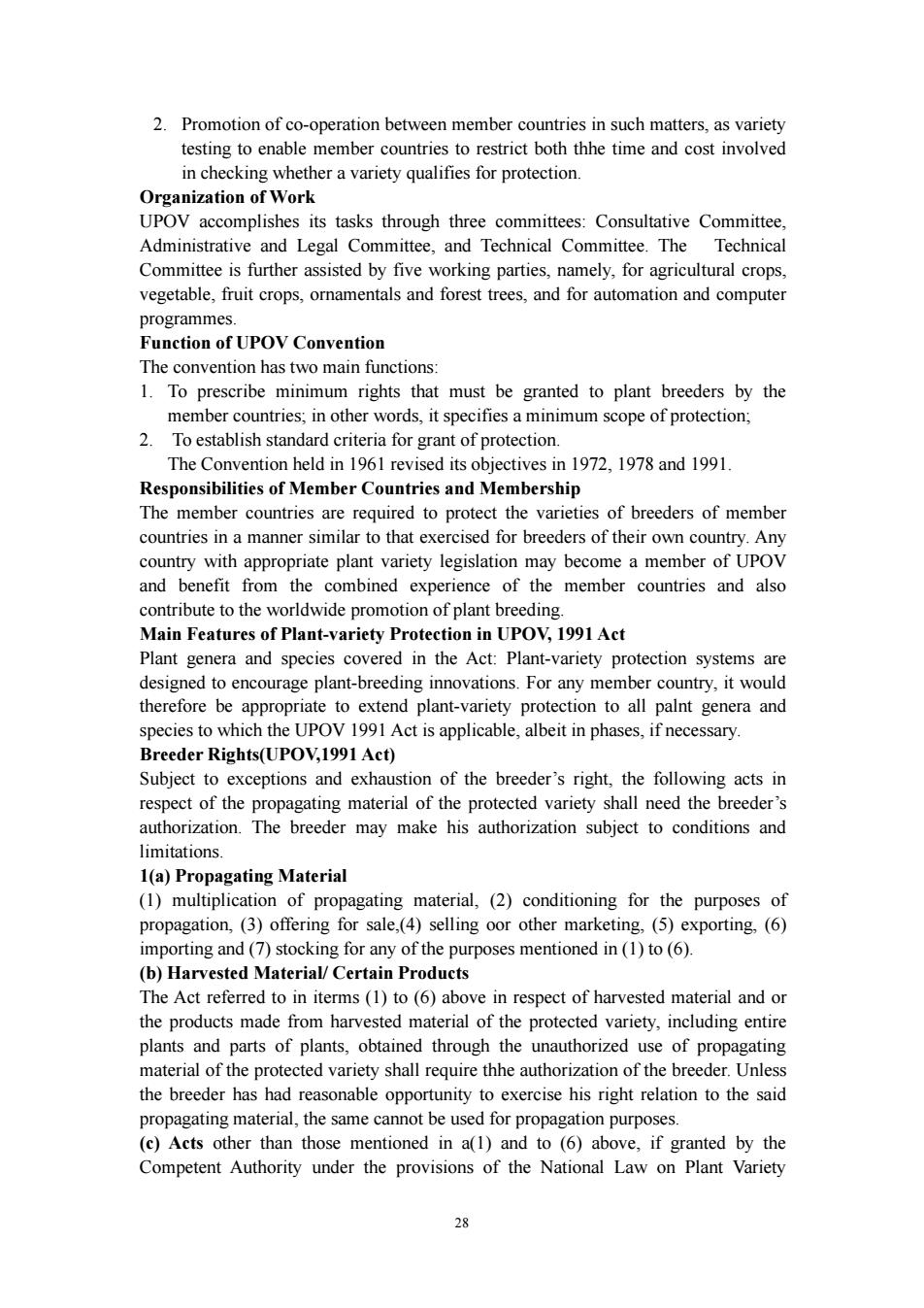
2.Promotion of co-operation between member countries in such matters,as variety testing to enable member countries to restrict both thhe time and cost involved in checking whether a variety qualifies for protection. Organization of Work UPOV accomplishes its tasks through three committees:Consultative Committee, Administrative and Legal Committee,and Technical Committee.The Technical Committee is further assisted by five working parties,namely,for agricultural crops, vegetable,fruit crops,ornamentals and forest trees,and for automation and computer programmes. Function of UPOV Convention The convention has two main functions: 1.To prescribe minimum rights that must be granted to plant breeders by the member countries;in other words,it specifies a minimum scope of protection; 2.To establish standard criteria for grant of protection. The Convention held in 1961 revised its objectives in 1972,1978 and 1991. Responsibilities of Member Countries and Membership The member countries are required to protect the varieties of breeders of member countries in a manner similar to that exercised for breeders of their own country.Any country with appropriate plant variety legislation may become a member of UPOV and benefit from the combined experience of the member countries and also contribute to the worldwide promotion of plant breeding. Main Features of Plant-variety Protection in UPOV,1991 Act Plant genera and species covered in the Act:Plant-variety protection systems are designed to encourage plant-breeding innovations.For any member country,it would therefore be appropriate to extend plant-variety protection to all palnt genera and species to which the UPOV 1991 Act is applicable,albeit in phases,if necessary. Breeder Rights(UPOV,1991 Act) Subject to exceptions and exhaustion of the breeder's right,the following acts in respect of the propagating material of the protected variety shall need the breeder's authorization.The breeder may make his authorization subject to conditions and limitations. 1(a)Propagating Material (1)multiplication of propagating material,(2)conditioning for the purposes of propagation,(3)offering for sale,(4)selling oor other marketing,(5)exporting,(6) importing and(7)stocking for any of the purposes mentioned in(1)to(6). (b)Harvested Material/Certain Products The Act referred to in iterms (1)to(6)above in respect of harvested material and or the products made from harvested material of the protected variety,including entire plants and parts of plants,obtained through the unauthorized use of propagating material of the protected variety shall require thhe authorization of the breeder.Unless the breeder has had reasonable opportunity to exercise his right relation to the said propagating material,the same cannot be used for propagation purposes. (c)Acts other than those mentioned in a(1)and to (6)above,if granted by the Competent Authority under the provisions of the National Law on Plant Variety 28
28 2. Promotion of co-operation between member countries in such matters, as variety testing to enable member countries to restrict both thhe time and cost involved in checking whether a variety qualifies for protection. Organization of Work UPOV accomplishes its tasks through three committees: Consultative Committee, Administrative and Legal Committee, and Technical Committee. The Technical Committee is further assisted by five working parties, namely, for agricultural crops, vegetable, fruit crops, ornamentals and forest trees, and for automation and computer programmes. Function of UPOV Convention The convention has two main functions: 1. To prescribe minimum rights that must be granted to plant breeders by the member countries; in other words, it specifies a minimum scope of protection; 2. To establish standard criteria for grant of protection. The Convention held in 1961 revised its objectives in 1972, 1978 and 1991. Responsibilities of Member Countries and Membership The member countries are required to protect the varieties of breeders of member countries in a manner similar to that exercised for breeders of their own country. Any country with appropriate plant variety legislation may become a member of UPOV and benefit from the combined experience of the member countries and also contribute to the worldwide promotion of plant breeding. Main Features of Plant-variety Protection in UPOV, 1991 Act Plant genera and species covered in the Act: Plant-variety protection systems are designed to encourage plant-breeding innovations. For any member country, it would therefore be appropriate to extend plant-variety protection to all palnt genera and species to which the UPOV 1991 Act is applicable, albeit in phases, if necessary. Breeder Rights(UPOV,1991 Act) Subject to exceptions and exhaustion of the breeder’s right, the following acts in respect of the propagating material of the protected variety shall need the breeder’s authorization. The breeder may make his authorization subject to conditions and limitations. 1(a) Propagating Material (1) multiplication of propagating material, (2) conditioning for the purposes of propagation, (3) offering for sale,(4) selling oor other marketing, (5) exporting, (6) importing and (7) stocking for any of the purposes mentioned in (1) to (6). (b) Harvested Material/ Certain Products The Act referred to in iterms (1) to (6) above in respect of harvested material and or the products made from harvested material of the protected variety, including entire plants and parts of plants, obtained through the unauthorized use of propagating material of the protected variety shall require thhe authorization of the breeder. Unless the breeder has had reasonable opportunity to exercise his right relation to the said propagating material, the same cannot be used for propagation purposes. (c) Acts other than those mentioned in a(1) and to (6) above, if granted by the Competent Authority under the provisions of the National Law on Plant Variety
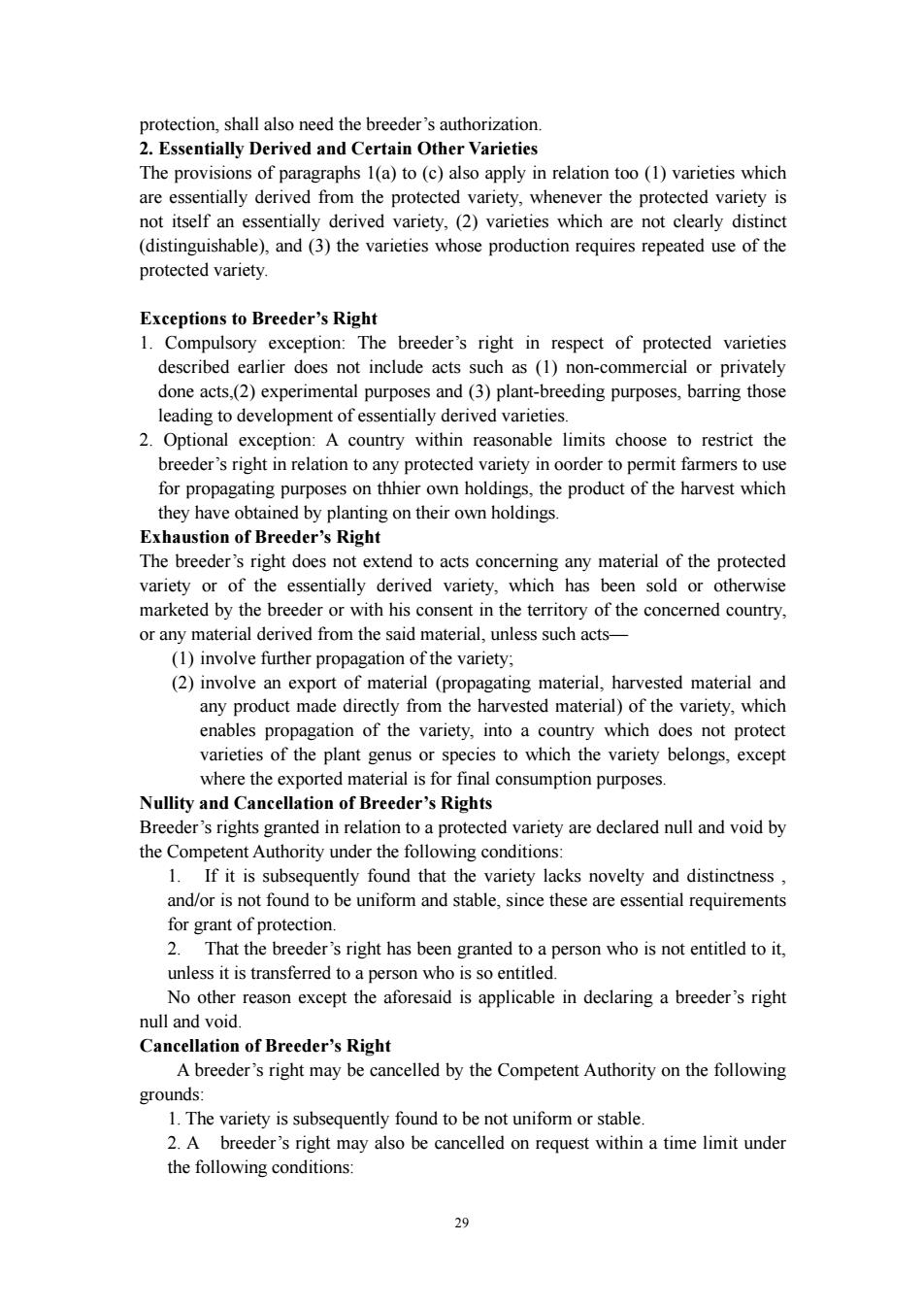
protection,shall also need the breeder's authorization. 2.Essentially Derived and Certain Other Varieties The provisions of paragraphs 1(a)to (c)also apply in relation too (1)varieties which are essentially derived from the protected variety,whenever the protected variety is not itself an essentially derived variety,(2)varieties which are not clearly distinct (distinguishable),and(3)the varieties whose production requires repeated use of the protected variety. Exceptions to Breeder's Right 1.Compulsory exception:The breeder's right in respect of protected varieties described earlier does not include acts such as (1)non-commercial or privately done acts,(2)experimental purposes and(3)plant-breeding purposes,barring those leading to development of essentially derived varieties. 2.Optional exception:A country within reasonable limits choose to restrict the breeder's right in relation to any protected variety in oorder to permit farmers to use for propagating purposes on thhier own holdings,the product of the harvest which they have obtained by planting on their own holdings. Exhaustion of Breeder's Right The breeder's right does not extend to acts concerning any material of the protected variety or of the essentially derived variety,which has been sold or otherwise marketed by the breeder or with his consent in the territory of the concerned country, or any material derived from the said material,unless such acts- (1)involve further propagation of the variety; (2)involve an export of material (propagating material,harvested material and any product made directly from the harvested material)of the variety,which enables propagation of the variety,into a country which does not protect varieties of the plant genus or species to which the variety belongs,except where the exported material is for final consumption purposes. Nullity and Cancellation of Breeder's Rights Breeder's rights granted in relation to a protected variety are declared null and void by the Competent Authority under the following conditions: 1.If it is subsequently found that the variety lacks novelty and distinctness, and/or is not found to be uniform and stable,since these are essential requirements for grant of protection. 2.That the breeder's right has been granted to a person who is not entitled to it, unless it is transferred to a person who is so entitled. No other reason except the aforesaid is applicable in declaring a breeder's right null and void. Cancellation of Breeder's Right A breeder's right may be cancelled by the Competent Authority on the following grounds: 1.The variety is subsequently found to be not uniform or stable 2.A breeder's right may also be cancelled on request within a time limit under the following conditions: 29
29 protection, shall also need the breeder’s authorization. 2. Essentially Derived and Certain Other Varieties The provisions of paragraphs 1(a) to (c) also apply in relation too (1) varieties which are essentially derived from the protected variety, whenever the protected variety is not itself an essentially derived variety, (2) varieties which are not clearly distinct (distinguishable), and (3) the varieties whose production requires repeated use of the protected variety. Exceptions to Breeder’s Right 1. Compulsory exception: The breeder’s right in respect of protected varieties described earlier does not include acts such as (1) non-commercial or privately done acts,(2) experimental purposes and (3) plant-breeding purposes, barring those leading to development of essentially derived varieties. 2. Optional exception: A country within reasonable limits choose to restrict the breeder’s right in relation to any protected variety in oorder to permit farmers to use for propagating purposes on thhier own holdings, the product of the harvest which they have obtained by planting on their own holdings. Exhaustion of Breeder’s Right The breeder’s right does not extend to acts concerning any material of the protected variety or of the essentially derived variety, which has been sold or otherwise marketed by the breeder or with his consent in the territory of the concerned country, or any material derived from the said material, unless such acts— (1) involve further propagation of the variety; (2) involve an export of material (propagating material, harvested material and any product made directly from the harvested material) of the variety, which enables propagation of the variety, into a country which does not protect varieties of the plant genus or species to which the variety belongs, except where the exported material is for final consumption purposes. Nullity and Cancellation of Breeder’s Rights Breeder’s rights granted in relation to a protected variety are declared null and void by the Competent Authority under the following conditions: 1. If it is subsequently found that the variety lacks novelty and distinctness , and/or is not found to be uniform and stable, since these are essential requirements for grant of protection. 2. That the breeder’s right has been granted to a person who is not entitled to it, unless it is transferred to a person who is so entitled. No other reason except the aforesaid is applicable in declaring a breeder’s right null and void. Cancellation of Breeder’s Right A breeder’s right may be cancelled by the Competent Authority on the following grounds: 1. The variety is subsequently found to be not uniform or stable. 2. A breeder’s right may also be cancelled on request within a time limit under the following conditions:
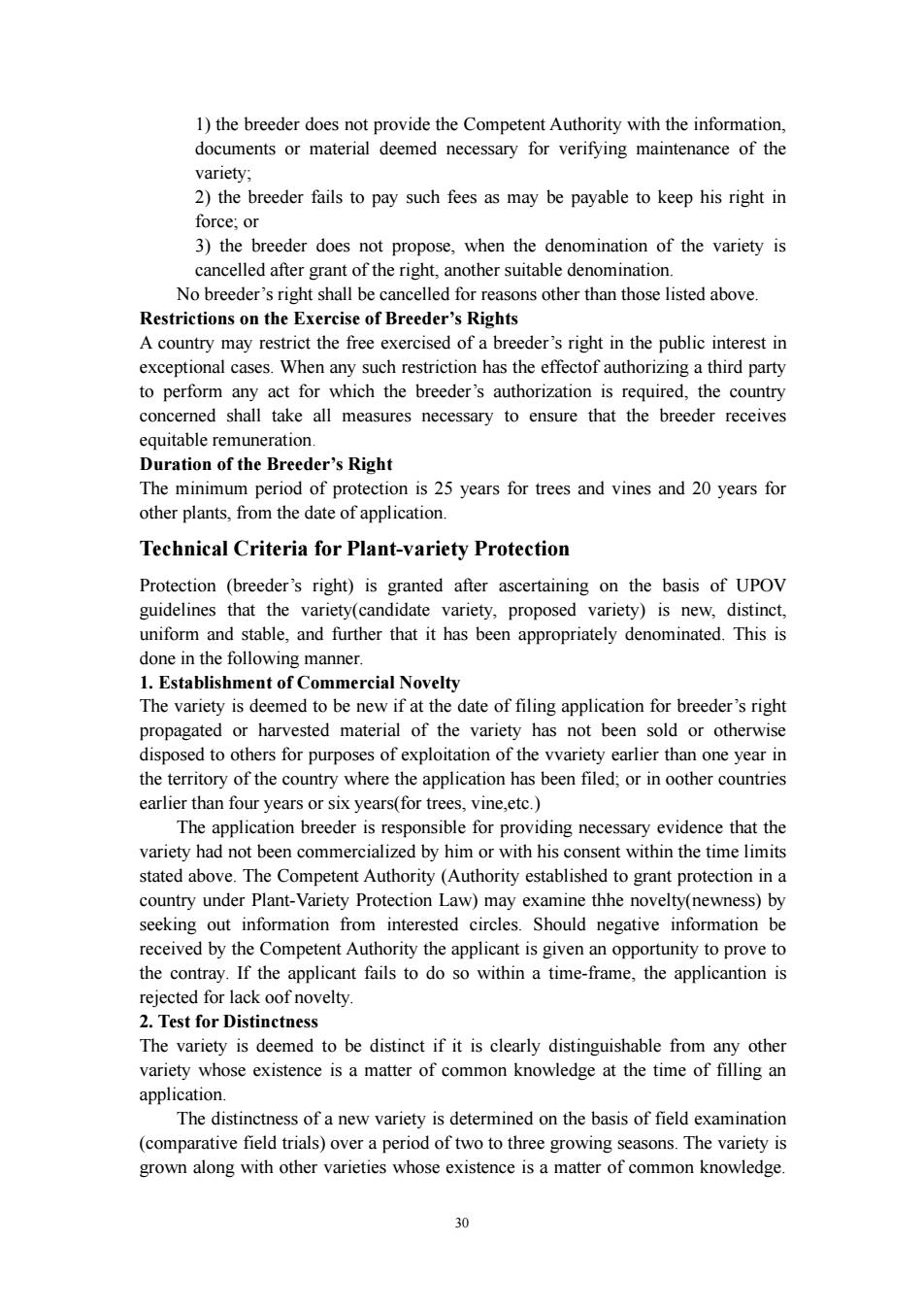
1)the breeder does not provide the Competent Authority with the information, documents or material deemed necessary for verifying maintenance of the variety; 2)the breeder fails to pay such fees as may be payable to keep his right in force;or 3)the breeder does not propose,when the denomination of the variety is cancelled after grant of the right,another suitable denomination. No breeder's right shall be cancelled for reasons other than those listed above. Restrictions on the Exercise of Breeder's Rights A country may restrict the free exercised of a breeder's right in the public interest in exceptional cases.When any such restriction has the effectof authorizing a third party to perform any act for which the breeder's authorization is required,the country concerned shall take all measures necessary to ensure that the breeder receives equitable remuneration. Duration of the Breeder's Right The minimum period of protection is 25 years for trees and vines and 20 years for other plants,from the date of application. Technical Criteria for Plant-variety Protection Protection (breeder's right)is granted after ascertaining on the basis of UPOV guidelines that the variety(candidate variety,proposed variety)is new,distinct, uniform and stable,and further that it has been appropriately denominated.This is done in the following manner. 1.Establishment of Commercial Novelty The variety is deemed to be new if at the date of filing application for breeder's right propagated or harvested material of the variety has not been sold or otherwise disposed to others for purposes of exploitation of the vvariety earlier than one year in the territory of the country where the application has been filed;or in oother countries earlier than four years or six years(for trees,vine,etc.) The application breeder is responsible for providing necessary evidence that the variety had not been commercialized by him or with his consent within the time limits stated above.The Competent Authority(Authority established to grant protection in a country under Plant-Variety Protection Law)may examine thhe novelty(newness)by seeking out information from interested circles.Should negative information be received by the Competent Authority the applicant is given an opportunity to prove to the contray.If the applicant fails to do so within a time-frame,the applicantion is rejected for lack oof novelty. 2.Test for Distinctness The variety is deemed to be distinct if it is clearly distinguishable from any other variety whose existence is a matter of common knowledge at the time of filling an application. The distinctness of a new variety is determined on the basis of field examination (comparative field trials)over a period of two to three growing seasons.The variety is grown along with other varieties whose existence is a matter of common knowledge. 30
30 1) the breeder does not provide the Competent Authority with the information, documents or material deemed necessary for verifying maintenance of the variety; 2) the breeder fails to pay such fees as may be payable to keep his right in force; or 3) the breeder does not propose, when the denomination of the variety is cancelled after grant of the right, another suitable denomination. No breeder’s right shall be cancelled for reasons other than those listed above. Restrictions on the Exercise of Breeder’s Rights A country may restrict the free exercised of a breeder’s right in the public interest in exceptional cases. When any such restriction has the effectof authorizing a third party to perform any act for which the breeder’s authorization is required, the country concerned shall take all measures necessary to ensure that the breeder receives equitable remuneration. Duration of the Breeder’s Right The minimum period of protection is 25 years for trees and vines and 20 years for other plants, from the date of application. Technical Criteria for Plant-variety Protection Protection (breeder’s right) is granted after ascertaining on the basis of UPOV guidelines that the variety(candidate variety, proposed variety) is new, distinct, uniform and stable, and further that it has been appropriately denominated. This is done in the following manner. 1. Establishment of Commercial Novelty The variety is deemed to be new if at the date of filing application for breeder’s right propagated or harvested material of the variety has not been sold or otherwise disposed to others for purposes of exploitation of the vvariety earlier than one year in the territory of the country where the application has been filed; or in oother countries earlier than four years or six years(for trees, vine,etc.) The application breeder is responsible for providing necessary evidence that the variety had not been commercialized by him or with his consent within the time limits stated above. The Competent Authority (Authority established to grant protection in a country under Plant-Variety Protection Law) may examine thhe novelty(newness) by seeking out information from interested circles. Should negative information be received by the Competent Authority the applicant is given an opportunity to prove to the contray. If the applicant fails to do so within a time-frame, the applicantion is rejected for lack oof novelty. 2. Test for Distinctness The variety is deemed to be distinct if it is clearly distinguishable from any other variety whose existence is a matter of common knowledge at the time of filling an application. The distinctness of a new variety is determined on the basis of field examination (comparative field trials) over a period of two to three growing seasons. The variety is grown along with other varieties whose existence is a matter of common knowledge